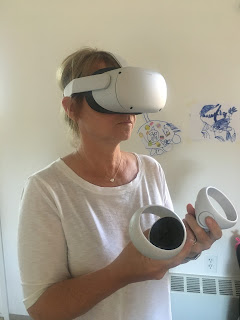Getting the Chunk Size Right
Being new to blogging and preparing to read the writings of two distinguished education technology experts, I decided to visit their blogs to learn something about them (Bates flies small planes and Dron plays swing guitar.) I read some of their posts written in a more informal voice and believe it was helpful as I read through my assigned chapters and articles.
but technology will never save bad teaching.” tonybates.ca
In his book, Teaching in a Digital Age (7.2), Bates provides a valuable and concise history of education technology. In it he outlines the seminal shifts that moved humanity from oral tradition, to written communication, through electronic media and to the learning technologies we recognize today. Bates describes the accelerated pace of technology in the last several decades, leading up to the ubiquitous nature of our current interface with digital media, most notably the Internet, as a “paradigm shift” in education.
I found it interesting that Bates posits that new technologies are often not truly new and that old technologies do not necessarily disappear but, rather, are integrated into modern ones...like the QWERTY keyboard.
"Usually the old technology remains, operating within a more
specialized 'niche', such as radio or integrated as part of a
richer technology environment, such as video in the Internet."-Bates
Drawing upon older technologies can offer educators options to address the varied learning styles of their students. No one learning technology need be the answer for all.
This article offered me an opportunity to contemplate the differences in terminology when referring to servers, browsers, the Internet, the World Wide Web and to explore the rich technological lexicon. This thinking prepared me to approach the more academic writing of Jon Dron.
Dron's article in Form@are, Open Journal per la formazione in rete (translation: for online training) is a scholarly piece which examines learning technology as it affects pedagogical choices. This reading was made possible through DOAJ which is a great source for online articles: https://doaj.org.
Dron takes a bit of time working through various definitions of "technology" and it was more confusing than clarifying. I found the following definition on Dron's home page easier to grasp.
"Technology' means organizing stuff to do stuff (any stuff), and we are
not just users but participants in that organization, either playing our roles correctly (hard technologies) or organizing stuff ourselves (sort technologies.)" JonDron.ca
Even more concise is Dron’s quoting of W.B. Arthur’s elegant definition of technology as “an orchestration of phenomena”.
Dron defines pedagogies as technologies and, in a behavioral context, it's easy to understand how various theories of human development can be applied to the decisions around creating and working with learning technologies, both hard and soft.
It was interesting to consider the distinctions between soft and hard technology and I appreciate that there are many available options when deciding upon appropriate learning technology. The combining of soft technologies to create hard ones allows for flexibility to accommodate myriad teaching styles and goals. The challenge, writes Dron, is "getting the chunk size right" - a phrase that will stay with me. The balance between soft and hard technologies is not a rigid equation but rather a question of ratio that is determined by pedagogical needs and by human and social interactions.
I had not previously considered learning technologies as a
subset of technology as a whole and, as an exercise in interfacing
with technology, this blog post has been a great learning opportunity.
~ J



In reference to Bates recognizing that there is an accelerated pace in tech in recent years: it is interesting to think about how we could possibly become more and more technologically advanced considering how mind blowing the internet is in the first place. It seems like the older advancements such as from radio to films to TV were easier to differentiate. Now, our advancements are far more complex to understand (such as the evolution of programming into multiple languages that interact with one another or how machine learning and artificial intelligence continue to gain more momentum in technology). The image you have in this article is a fantastic breakdown of tech evolution through history, and supports this idea that it seems like tech advancements were more easily differentiable in the past as they are today. Just something interesting to think about. Super interesting thoughts you have overall!
ReplyDeleteThank you, Kevin. I went through several iterations of images to show the accelerated pace of learning technologies. I'm glad you liked the one I chose.
DeleteI thought the way you structured this blog was phenomenal, as it lead to quite a captivating reading experience. I appreciated the use of images and quotations which provided context and helped with getting a better sense of your analysis. I truly felt after reading that I got an in depth look of your feelings and interpretations of these articles. Great Job!
ReplyDeleteThank you, Andrew!
Delete